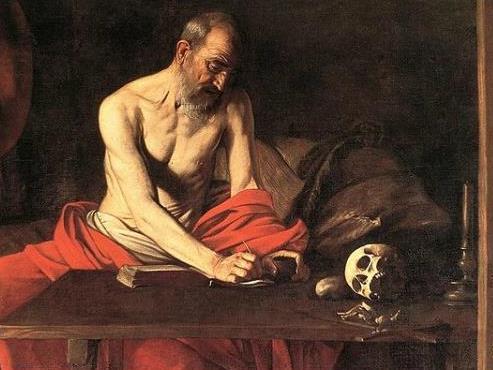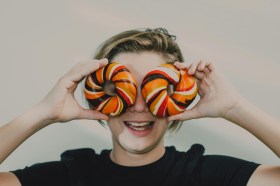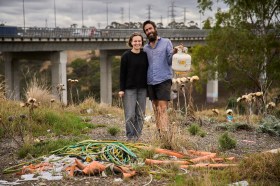Detail of Caravaggio’s painting Saint Jerome Writing c.1607-1608. St. John’s Co-Cathedral, Valletta. Saint Jerome is considered the patron saint of translators, librarians and encyclopedists. Public Domain via Wikimedia Commons
Judith White’s Culture Heist: Art versus Money is a scathing exposé of the Art Galley of NSW’s (AGNSW) current management and Sydney Modern plans.
The “insiders view” is informed by White’s time as Executive Director of the Art Gallery Society of NSW, a position she held for two terms (2000-2008 and then again in 2013-2015), following her time as Editor of Look, the Art Gallery Society’s magazine from 1998-2000.
She opens her book with a quote from William Shakespeare: ‘All that glisters is not gold’, followed by word from a Society member: ‘What happened to our Gallery? It feels as though it’s been hijacked.’
White says that this “heist” has taken place behind closed doors, and blames the ambitions of Director Michael Brand and his Sydney Modern project (with its ‘provisional pricetag of $450 million’) for gutting her once-beloved organisation.
David Levine, Member of the Council for the Art Gallery Society, calls Brand’s pursuit of the new gallery as ‘pharonic’, and says White’s book corrects the record.
He believes that the special ambience that the gallery once offered has ‘given way to a certain vulgarity’ and that White chronicles how that has happened.
Claims of rot at the core
White accuses the gallery of having ‘acquired layers of bureaucracy’ since Brand was appointed, adding, ‘announcements and directives came from management couched in language to rival George Orwell’s Newspeak.’
She said that the roll out of redundancies and the removing of volunteers from duties added to the Gallery’s destablising.
White’s overarching criticisms, however, lie in the claim that Brand got the timing wrong for Sydney Modern, placing a great institution in jeopardy. She believes the gallery was a ‘latercomer to the vogue for museum expansion’ and that the timing of the Sydney Modern’s announcement did not sit well with the broader funding climate.
The unwritten accusation is that Brand’s inability to correctly gauge this pulse has lead to the gallery’s demise. It is a really tough book, and while White navigates readers through a sea of well researched details, the tone is questionably a little too acerbic.
Cuts and gag orders
White makes a point that on Black Friday – the day in May 2016 when 62 small to medium organisations lost their funding from Federal Government – Brand started his wave of staff redundancies, despite being a signatory of support for the sector against the government cuts.
While no one could have predicted the timing of events on that Black Friday – it truly came out of nowhere – White adds that in the previous week, Gallery staff had been required to sign a new code of conduct forbidding public comment (approved by Trustees in December 2015, but not issued until eve of redundancies in May 2016).
She quotes The Saturday Paper: ‘The gag order, wrote columnist and lawyer Richard Ackland, would have made even Attorney-General George Brandis blush.’ (25 June 2016).
White refused to sign the order and resigned. It meant that a Memorandum of Understanding between the Society and AGNSW – what White calls a ‘Memorandum of Misunderstanding’ – broke down, as did her professional relationship with Brand.
Those close to White know that she fought bitterly against Brand’s bid to funnel AGNSW Society fundraising towards Sydney Modern, instead of towards acquisitions – which are not funded by government – as had been traditional.

Soap opera antics
While reading this book could rival the best TV soap – it’s a page-turner dripping with acid – White does offer a clear pathway through a very complex timeline of the past five or more years, starting prior to Brand’s appointment when the Gallery was still under Director Edmond Capon’s control, and leading up to April 2017.
It is a period that has seen considerable change and outcry – behind closed doors, as one of Australia’s oldest cultural organisations slowly ruptured from the inside, and very publicly, including prominent voices venting in the press. Former Prime Minister Paul Keating even joined the camp of “Sydney Modern bashers” with claims of a ‘land grab’ and criticism of Brand’s vision as ‘a large entertainment and special events complex masquerading as an art gallery’.
That was in April 2014, when the Royal Botanic Garden and Domain Trust released a draft master plan that referred to the proposed AGNSW extension, White explains. It came after a year of backlash since the project was announced.
Four years later and the tables have turned. Culture Heist was released last month, shortly before this week’s surprise announcement by the NSW Government that it would fund the gallery’s Sydney Modern project to the sum of $244 million.
Read: $244 million gives Sydney Modern green light
White used the moment to comment further: ‘Expansion on this scale cannot possibly succeed without a major improvement in recurrent funding over the coming decades, running to many hundreds of millions of dollars. Will the State Government commit to picking up the bill for the projected 240 additional jobs and for maintenance, heating and lighting for the next 50 years?’
Writing on her blog, White continued: ‘The business case for Sydney Modern appears to rely heavily on commercial revenue, turning the Art Gallery into a corporate function centre. And if bureaucratisation, commercialism and outsourcing are allowed to continue at the present rate, the curatorial culture required to make the new building a success will be impossible to regenerate.’
Not all share White’s view. Many artists and supporters this week have been vocal in congratulating the NSW Government’s decision in building a future for Sydney, rather than continuing to wallow in discontent.
What White’s book does is lay the blame very much at Brand’s feet. She does, however, point out that it was in fact Capon and his Deputy Anne Flanagan who envisaged the plan for a newly sited gallery extension, a vision that was heavily championed by Flanagan after Capon’s retirement and prior to Brand’s appointment.
While White’s message is very clear, there are several side stories within Cultural Heist that require broader consideration.
In the book, White targets Brand’s salary as excessive compared to Capon’s and colleagues at the Tate and British Museum, and she is just an ink blotch shy of accusing Brand of corporate nepotism when it comes to Board relationships, raising questions that have circulated across the sector on the Board’s responsibility to dig deep and support financially.
She writes: ‘Over a period of 25 years it passed from Frank Lowy, founder of the Westfield shopping centre empire (1989-1996), to his close associate, Westfield board member David Gonski (1997-2006) and then to his son Steven Lowy (2007-2013). And after two years with Guido Belgiorno-Nettis of Transfield at the helm, in 2016 it went back to Gonski.’
White continues: ‘At the time of the Sydney Modern announcement in 2013 the AGNSW had reputedly the wealthiest board of any arts organisation in Australia.’
Elsewhere, she makes the point that just prior to the announcement of the Sydney Modern project in 2013, the Lowy family sold a stake in the Westfield Retail Trust for $663.7 million. The subsequent donation that was anticipated did not come at the project announcement, not has it arrived to date.
As part of this week’s announcement from government and Gallery, and in addition to the $244 million already promised over the next three years in state funds, a capital campaign (to be officially launched later this year) is expected to raise $100 million in philanthropic support for the project, of which $70 million has already been pledged.
ArtsHub asked the Gallery where that pledged $70 million has come from, and how watertight those promised gifts were. A Gallery spokesperson responded that that information was unable to be released at this point. Sadly, this lack of transparency appears to support White’s arguments rather than building off the positive momentum of this week’s announcement and demonstrating that the Gallery has had successive wins.
Can leveled criticism aid or harm an institution?
At the time of Culture Heist‘s publication, The Australian reported an AGNSW spokeswoman as saying: ‘Ms White’s criticism of the gallery and individual members of staff is unfortunate and is in telling contrast with relations between the Art Gallery and the Art Gallery Society’, and adding that the book contained ‘numerous factual errors’.
There seems to be considerable cat-and-mouse games surrounding this project at the expense of transparency, with players on both sides of the fence. It would seem that everyone has an agenda.
In the wake of the launch of White’s book I have heard her championed as a brave voice – with Culture Heist described as a much needed rallying call for those who are alarmed by the way art museums are being transformed into corporate entities – but also criticised, with the book called venomous and inappropriate. The Australian‘s Michaela Boland described it as ‘a must read for all those who treasure the arts.’
The New York Times even picked up on the case, hanging out our dirty laundry for global examination – what does that do to reputations?
It might be juicy reading, but I don’t see any outcome other than bitter scandal. There is even the feeling that at times, White is skating on thin ice in terms of slanderous personal attack.
While it is no public secret that Brand is not as loved as Capon was – both by staff and in the public eye – what the AGNSW really needs now is the opportunity to repair those ruptures of the past five years. For some, this week’s announcement has offered that exactly that opportunity, and with Brand’s contract renewed for just 12 months to shepherd Sydney Modern through the initial fundraising period, today is a very different day than yesterday.
The Art Gallery of NSW is a far greater institution than just a handful of people. It returns me to where White started her book. ‘The AGNSW today is a prime example of a cultural institution under stress,’ she writes. To use a colloquialism: do you continue to kick a man when he is down? No you extend a hand and help them up.
The Gallery continues to have many staff who are passionate about the delivery of professional and scholarly programs to the public, and who are charged with dedicated collection care. White’s book tends to wipe them from the slate via the sweep of redundancies and the newly introduced “consumer culture” of the Gallery. From this reader’s perspective that is grossly unfair.
The changes at the AGNSW have been huge – both to the organisation, and more broadly as it sits within a sector that has been called on to be more accountable and sustainable. Many arts organisations across Australia have been challenged, and change for some is harder than others. I support White’s view in that the handling of many of those changes at the AGNSW were inappropriate, insensitive and poorly managed, and their results damaging.
I do encourage a read of Culture Heist for anyone working in the visual arts. These have been complex times and this book might just offer a road map to understanding our new world – a map that extends well beyond the impressive columns of the Art Gallery of NSW.
Review Rating: 3 out of 5
Culture Heist: Art versus Money
Author: Judith White
Published by Brandl and Schlesinger.
RRP: $29.95





